catalogs
3.1.2 Analysis of user work requirements
3.2 System Functional Requirements Analysis
3.3 System Functional Use Case Analysis
3.3.2 Participant use case analysis
3.4 System feasibility analysis
4.1 Overall system functional design
4.2.2 Sector management module
4.2.3 Employee management module
4.2.4 Customer management module
4.2.5 Order Management Function Module
4.2.6 Notification management module
4.2.7 Warehouse management module
4.2.8 Transportation management module
5.1 Administrator Login Module Implementation
5.2 Administrator home page functionality implementation
5.3 Departmental management module implementation
5.4 Employee Management Module Implementation
5.5 Order Management Module Implementation
5.6 Customer management module implementation
4.7 Notification management module implementation
5.8 Warehouse management module implementation
5.9 Transportation Management Page Implementation
5.10 Customer Login Page Implementation
4.11 Customer Home Page Functionality Implementation
1 System overview
This paper focuses on the demand study of information technology management in logistics companies, clarifies the benefits that the degree of information technology can provide for the enterprise, and uses UML modeling graphics to construct the system requirements and functional models. Also studied the temperature monitoring technology, hope to be able to design and develop these features can be added to it. The system uses JAVA combined with MVC development model and SSM framework to design the database and all data table structure to meet the system, complete the classes and methods corresponding to the realization of each functional module of the system, and successfully complete the system development and page design. The design and development of this system not only improves the operational efficiency and technical level of the enterprise, but also improves the transportation efficiency.2 System-related technologies
The system currently utilizesMVCThe development model is similar to theSSMThe framework was developed and designed, whereMVCThe development model i.e.Model(Model),View(view),Controller(Controller).MVCThe advantage of the good scalability, definition of interceptors, function module layering can be achieved in a layered development, clear hierarchy。

SSMattributableSpring+SpringMVC+MyBatisThe integrated architecture provides a standardized, easy-to-use, and easy-to-use solution forMVCModel, FigurecenterSSMSchematic modeling of the framework. Among them, theSpringThe framework also provides the ability to createWebFull functionality of the applicationMVCModel.Spring MVCSeparating the roles of controls, model objects, filters, and handler objects makes it easier to customize, easier to integrate with other components, and easier to use.ViewThe framework is seamlessly integrated and utilizes theIOC(control reversal) for testing purposes.
MyBatisright.JDBCEncapsulation is performed to make the underlying operation of the data transparent.MyBatisis centered aroundsqlSessionFactoryinstance runs, it gets the entity class through the configuration file to perform the databaseSQLLanguage mapping. Each time the database is accessed, thesqlSessionFactorygainSQLSessionAfter that, execute theSQLStatements. For a clearer understanding of theSSMProcessing, Fig.This is a diagram of how a user’s request is processed. The user sends a request, gets the values of the attributes one by one from top to bottom, then goes to the database to get them and then returns the values from the database to the user. In theSpringprogressWebWhen the page is designed, theB/SThe model isWebThe architecture of the browser istoServer model, in this model, with a unified interface, simple client, and can exist cross-platform, easy to maintain and optimize the。
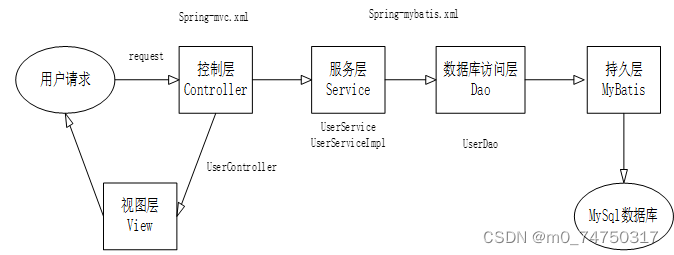
The construction of databases, on the other hand, is mostly done withMySQLto realize the saving of information.MySQLIs an object database , its powerful , cross-platform support , fast , but also for all objects , and good stability , low cost , but also supports a variety of assembly language , large storage capacity , and its own built-in rich functionality .
3 Requirements analysis
3.1 Requirements Analysis Concepts
Requirements analysis is the task to be carried out in the beginning stage, mainly to the user, to obtain the user’s needs for the system to be integrated, the corresponding requirements analysis document will be formed. It is also an important stage for developers to have a general understanding of the system.
3.1.1 User workflow analysis
Logistics information technology is the application of modern information in all aspects of logistics operations. In order to clarify the work process of logistics enterprises, the workflow of all departments in the enterprise for the general unified analysis, the figure is the general process analysis of the operation of logistics enterprises, through the analysis of the general business, mainly including receiving, storage, transportation of the three links.
1. Receiving link
When the customer needs the goods, contact with the logistics company by phone or network and other methods. The process of receiving the goods is arranged by the company for the driver to go ahead and load the goods. When the loading is finished, you will get the delivery note, which will have the information of the goods on it.
2. Storage links
Warehousing occurs mainly in the process of soliciting goods and the process of unloading goods after arrival at the station. Warehousing includes the loading of goods in the warehouse at the time of solicitation and the unloading of goods at the time of arrival, as well as the categorization and storage of goods.
3. Transportation links
Transportation link is the company according to the goods for transportation scheduling, arranging the corresponding driver vehicle. Mainly occurs at the beginning of the pick-up and from the warehouse after loading the goods in the transportation process. When loading the goods, you need to open the bill, and after unloading the goods at the station, you need to open the receipt.
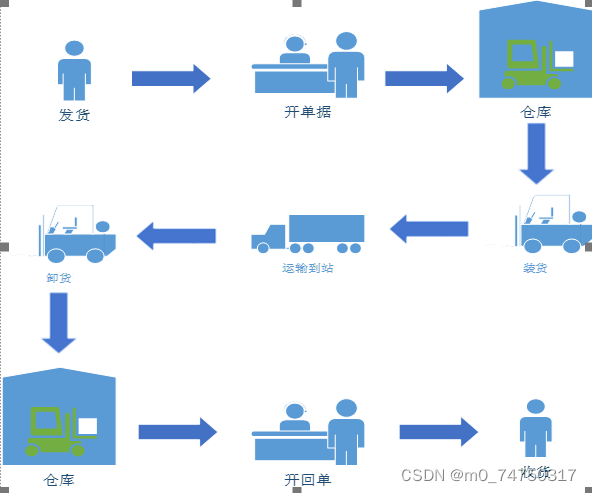
3.1.2 Analysis of user work requirements
Through the analysis of the overall flow chart of the enterprise, it can be summarized that the user in the work of the various business management information processing needs. Probably mainly includes the following aspects:
1. Management of data
Logistics and transportation companies need a variety of data to support the operation of the business. For example: employee information, vehicle information, warehouse information. These information will let the system unified management, can enhance the information query ability, improve the efficiency of data management.
2. Management of notifications
In order to ensure the timeliness of the message, the company needs to issue notifications internally and externally in a timely manner. The computerization of notification management improves the efficiency of notification work.
3. Order tracking management
The orders of the logistics and transportation company are throughout the overall three links. The system should have the ability to track the orders and be able to query the orders through conditions such as the order number.
The figure summarizes the functions that the whole system should have, which mainly includes the main functions of departmental employee management, customer management, transportation management, warehouse management, notification management and so on.
3.2 System Functional Requirements Analysis
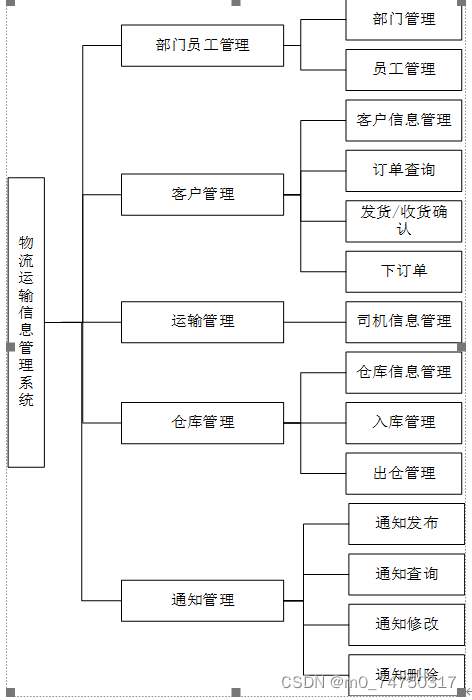
Departmental employee management includes functions to manage the basic information of employees and departments. Customer management is the management of the basic information of the customer and the management of the customer’s own notification and order status and other functions. Transportation management is mainly the information management of drivers and vehicles. Warehouse management is mainly the management of goods out/in and the management of warehouse goods information. Notification management includes notification query, as well as add, delete and change operations.
3.3 System Functional Use Case Analysis
3.3.1 participants
The participants are the representatives of the system users. The figure shows an analysis of the users of the logistics and transportation information system.
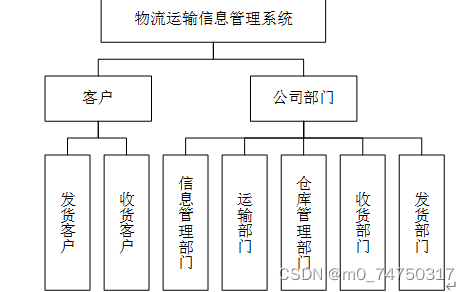
According to the figure, it can be seen that the users of the logistics and transportation information management system are mainly divided into customers and company departments. Customers are divided into two categories: shipping and receiving customers. The company department users are a generalization of all the departments of the company.
1. System administrators
The system administrator is an abstraction of the person who manages the overall department of a logistics and transportation company. The system administrator is responsible for the management of each department, the management of transportation tasks, the management of customer information, the management and maintenance of employee information, and so on.
2. Customers
Customers are an abstraction of shipping and receiving customers, represented by customer participants. Customers can log in successfully to place orders, inquire about orders, and confirm the status of shipping and receiving.
3.3.2 Participant Use Case Analysis
- System Administrator Use Case Analysis
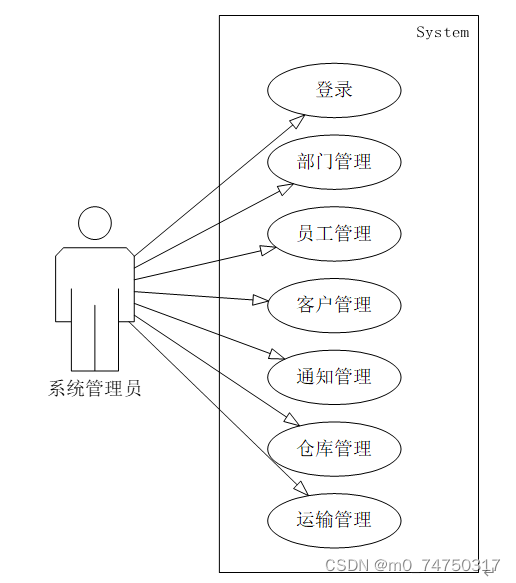
Based on the daily work of the system administrator, the system administrator functional use case analysis diagram of Fig. is analyzed and obtained.
Public use cases: administrators logging in to the system, etc.
Department management use case: Used to manage all the departments in the company and realize the management operation related to department information.
Employee management use case: used to all departments under the basic employee information for basic additions, deletions, changes and checks, which also includes the driver’s information related to the operation, the driver belongs to the transportation sector employees.
Customer management use case: mainly to view the customer’s information, and then modify, add, delete operations.
Transportation management use case: administrators view transportation task information, after which they can perform actions such as adding and modifying status.
Notification management use case: Notification management is an abstraction of the functions of the information department, which is used to query and index various notification information, as well as to manage operations such as adding, modifying and deleting.
Warehouse Management Use Case: Warehouse management is an abstraction of the warehouse department, used to manage the basic information of the goods in the warehouse, as well as some of the information in the warehouse, the information management of the goods, as well as the goods in and out of the warehouse operations.
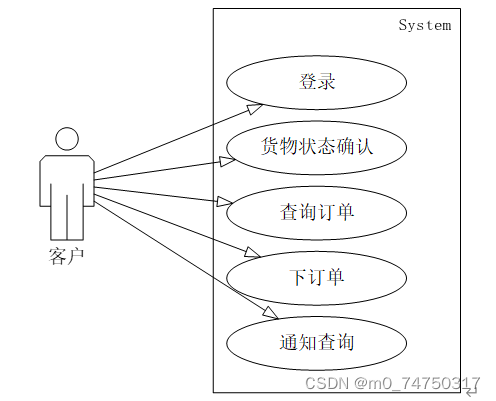
The customer is an abstraction of the receiving/shipping customer, and the diagram is an analysis of the customer’s needs for the required functionality of the system.
The customer’s functional use case requirements included features such as status confirmation, order inquiry and order placement.
Login Use Case: Used for the basic login operation of the client;
Query Order Use Case: After the customer has successfully logged in, he/she can query the order information through the homepage, so as to know the basic status of the order.
Status Confirmation Use Case: Customers are able to perform status confirmation operations after completing an order or after receiving goods. Shipping confirmation is a function of the shipping customer in order to confirm that the goods have been sent. Receiving confirmation is a function of the receiving customer to confirm that the goods have been received.
Notification Query Use Case: Customers can get the latest messages sent by administrators through notification queries.
Order Use Case: Customers can add orders on the order page and can only place orders for goods that have already been shipped.
3.4 System feasibility analysis
System feasibility analysis is a system designed out of the essential links, according to the logistics and transportation information system access, as well as taking into account the system’s later operation and post maintenance of the actual situation, the analysis of the system feasibility analysis program, mainly including the following aspects:
1. Economic feasibility
This system was designed after a time consuming process of a few weeks, after many literature analysis, and field trips to analyze the design, the cost as well as the time spent is not a lot, just need to set up the environment for the system to run. The system is feasible as it requires less hardware so the development cost is low.
2. technical feasibility
The system is developed and designed using JAVA language, which reduces the development effort and cost, decreases the coupling degree of components, and improves the maintainability and scalability of the software in order to meet the needs of the information management system. The database technology is implemented with MySQL. And considering the future progress of the technology, new functions can be designed in the future based on the existing functions and according to the actual needs.
3. operational feasibility
The system design is simple and practical, to ensure that it can operate normally, with operability, and general customers normally after a short period of professional training, but also be able to skillfully master the various operations of the system. The system realizes the function simply and quickly. So the system has operational feasibility.
4 System Design
4.1 Overall system functional design
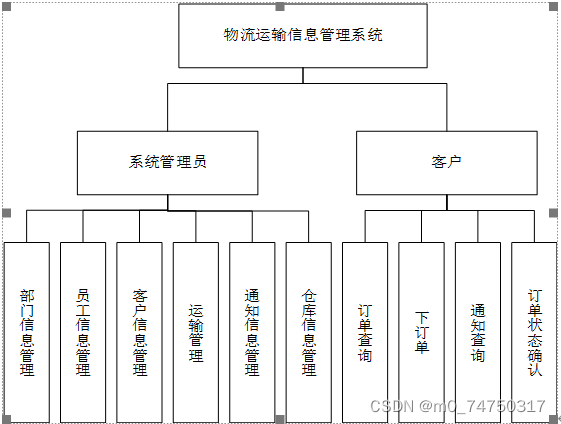
After the results of the requirements analysis document of the system, it was concluded that there are two types of users, system administrators and customers. Different roles should have their corresponding functions. After logging into the system, the administrator can control certain operations such as departmental information, employee information, warehouse information, customer information, transportation information, and so on. Customers can log in to inquire about order details, place orders, and confirm the status of goods and other operations.
4.2 System module design
4.2.1 Login Module
This module mainly realizes the login operation of the system for administrators and customers, which guarantees the system security. The figure shows the flow chart of administrator and customer login.
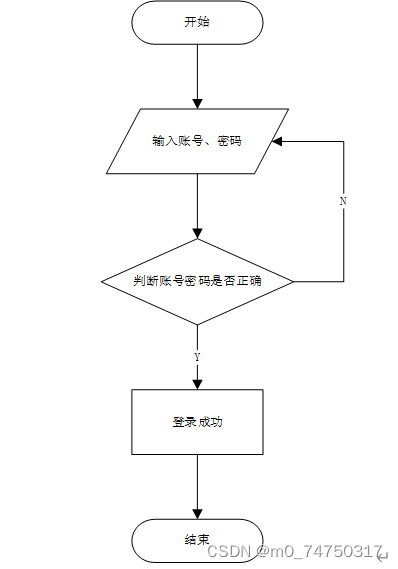
4.2.2 Departmental management module
This module is mainly the administrator login to the basic information of the company department of the basic operation of adding, deleting, changing and checking. The figure shows the structure of the department management module.
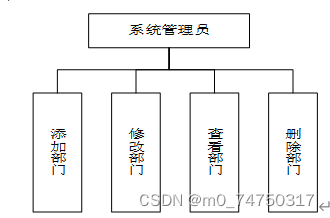
4.2.3 Employee Management Module
This module is the basic operation that the administrator can perform for the employee’s information. The figure shows the structure of the employee management module.
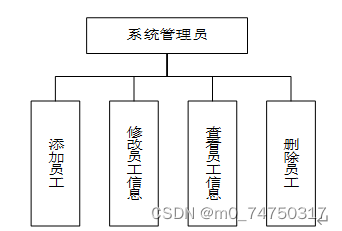
4.2.4 Customer Management Module
Administrators through the module on the customer information related to management operations. Administrators can view, add, modify and delete some of the basic information of the customer after logging in successfully, the figure shows the structure of the customer management module.
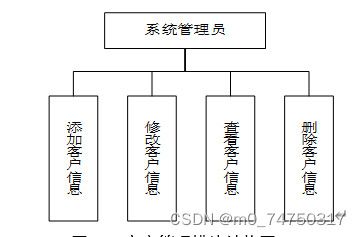
4.2.5 Order Management Functional Module
The figure shows the structure of the order management module. Customers can view the order information and goods information after logging in successfully, as well as placing orders and confirming the status of goods.
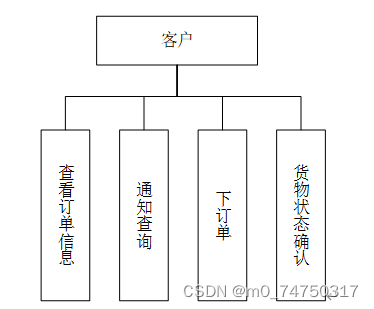
4.2.6 Notification Management Module
The notification management module is mainly used by the system administrator to manage the notification information. The administrator can view the notification information, add the notification information, modify the notification information, and delete the notification information after successfully logging in. The figure shows the structure of the notification management module.
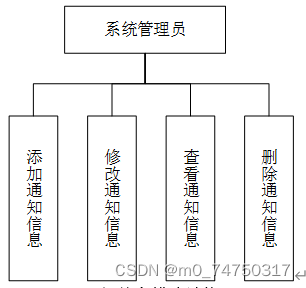
4.2.7 Warehouse management module
The module mainly contains information about the goods, can be viewed, but also can be out of storage, storage operations, etc., the figure shows the structure of the warehouse management module.
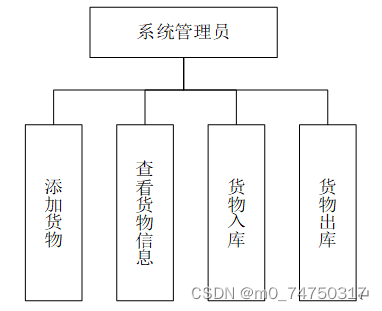
4.2.8 Transportation management module
This module is mainly for administrators to operate on transportation tasks, through this module administrators can perform the following behaviors on transportation tasks. The figure shows the structure of transportation management module.

5 System Implementation
5.1 Administrator Login Module Implementation
The figure shows the administrator login page of the logistics and transportation information management system. The administrator logs in with the corresponding administrator account and administrator password and enters the administrator homepage. If the account and password are not correct, it is impossible to log in and enter the administrator homepage.
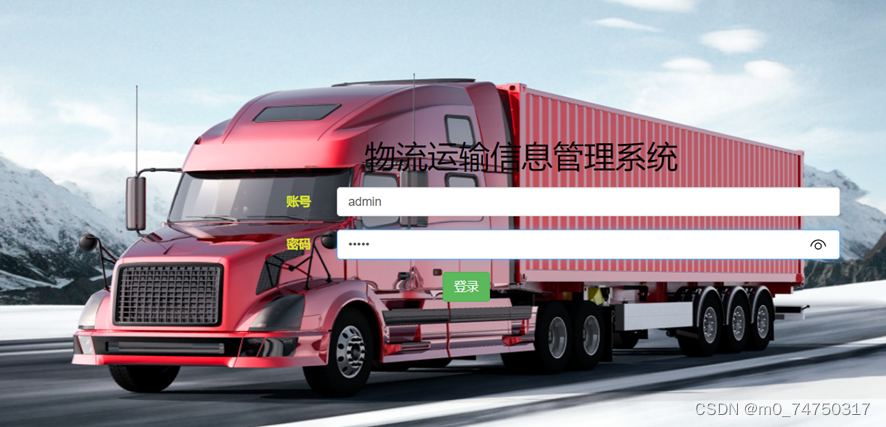
5.2 Administrator home page functionality implementation
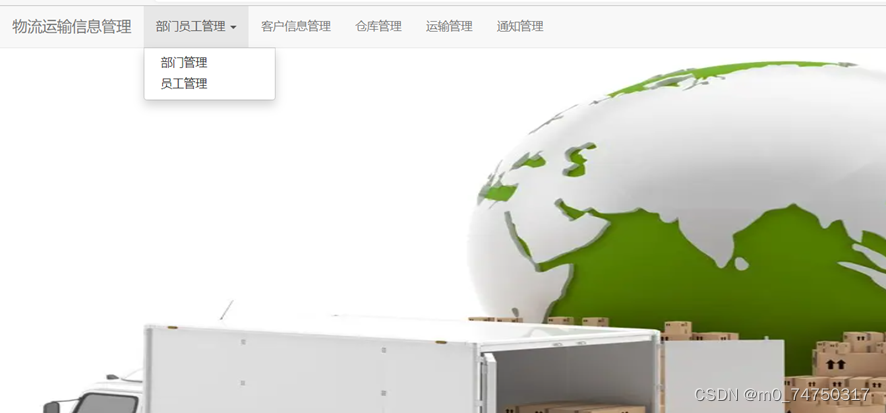
Figure for the administrator home page, the administrator through the page can realize the management of the department, staff management operations, as well as customer information, warehouse information, transportation management, notification information for the corresponding management operations, which information can be displayed on a page, according to the number of items of information displayed on each page, you can view the page. After the operation, the data will be saved in the database.
5.3 Departmental management module realization
The department management module of this system mainly operates on departmental information. In the current administrator page, the data information after adding departments, modifying information and deleting departments will be transferred to the departmental information table in the database for storage. The figure shows the department information management page.
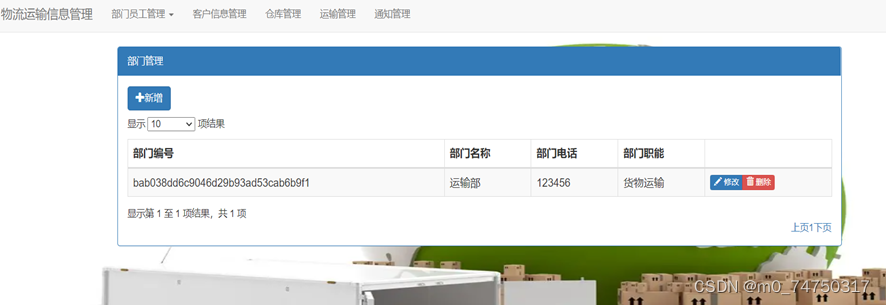
5.4 Employee Management Module Implementation
The employee management module of the system mainly includes the functions of adding, modifying and deleting the name, telephone number, department and function information of the employees in each department. Administrators of the employee information related to the operation after the data transfer to the background database for preservation. The picture shows the employee information management page.
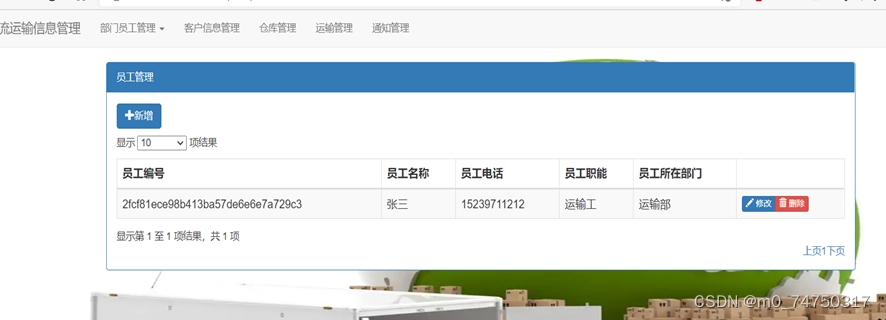
5.5 Order Management Module Implementation
This page allows customers to modify the status of orders and add orders. After making relevant operations on the order information, the data is saved to the corresponding data table. The figure shows the order information management page.
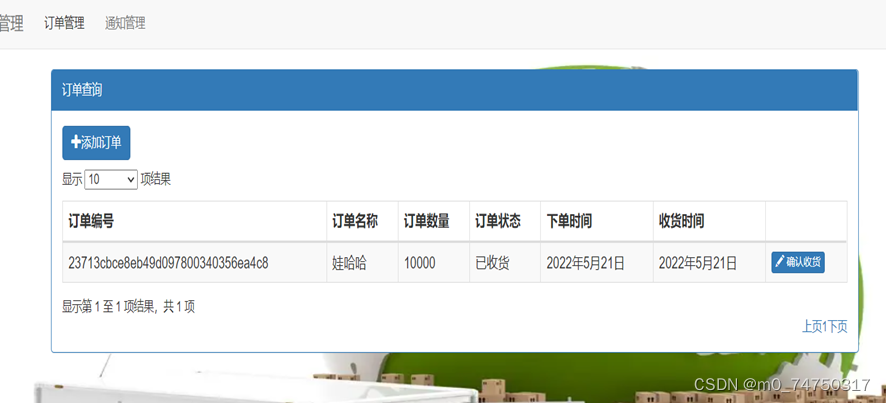
5.6 Customer Management Module Implementation
The customer management module of this system is mainly used to part of the customer’s information related to the operation, view can only view the customer’s number, name, phone address of these basic information, in the page to the customer information operations are completed and saved in the customer information table. Figure for the customer information management page.
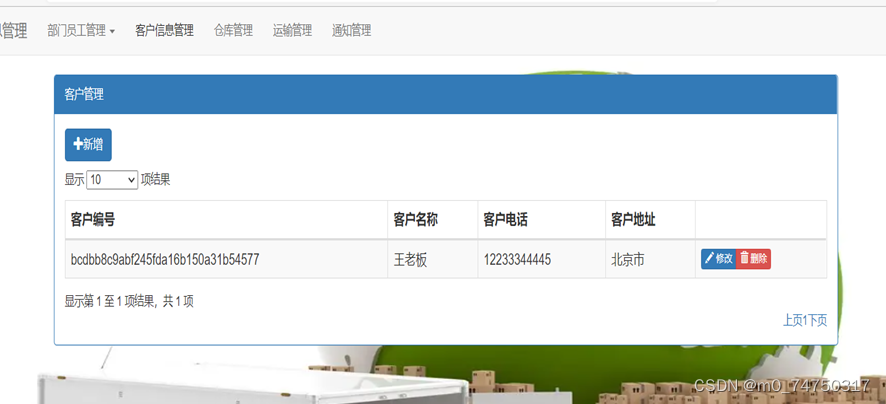
4.7 Notification Management Module Implementation
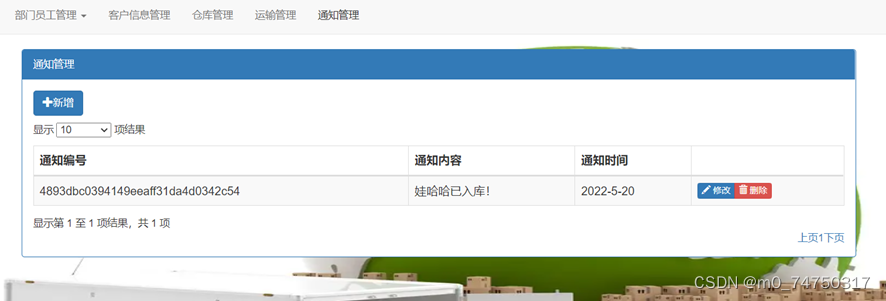
The administrator stores the data in the database after performing basic management on this page. The figure shows the notification management page. It is shown in the above figure.
5.8 Warehouse management module realization
Figure for the warehouse management page, warehouse management module functions mainly include the administrator of the warehouse goods information to add, modify and other operations, inbound, outbound mainly on the status of the goods of an operation. This module can view the goods where the warehouse number, the name of the goods, the goods number, the number of goods, the status of goods information. As shown in the figure below:

5.9 Transportation Management Page Implementation
The Transportation Management page is one of the options available to the administrator on the main page. One of the main operations is related to transportation tasks, mainly adding and modifying transportation tasks. Here you can only add shipments for which the user has placed an order. The start time appears after the transportation is started, and the end time appears after the customer confirms receipt of the goods. The picture shows the transportation management page.

5.10 Client Login Page Implementation
The customer login page is similar to the administrator login page, basically, except for the account password is different, the login process is the same. As shown in the figure, the customer login page is similar to the administrator login page.
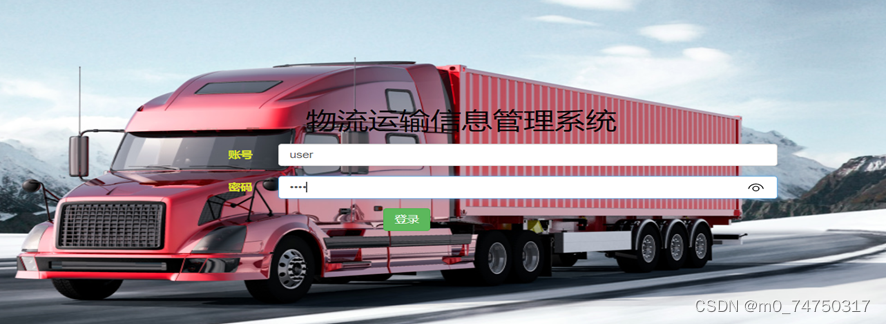
4.11 Customer Home Page Functionality Implementation


Customers can query the notification and order information after logging in, as well as placing orders and making changes to the order status. Customers can only add goods in the warehouse under the outgoing status when placing orders, and after placing an order, the administrator can only add the transportation task to start shipping, and after that, the customer can only confirm the receipt of the goods, or else there will be an error. The picture shows the realization of the customer’s order inquiry page and the picture shows the realization of the customer’s order placing page.

Customers can also make inquiries on the notification page to get cargo news conveniently. The picture shows the customer’s notification inquiry page.
6 Summary
The main purpose of this article is to analyze the requirements of the system, design a requirement analysis plan, confirm the functions of the system to be used, and expressed through the UML modeling language, and according to the requirement analysis plan of the system for each functional module of the detailed design, through the JAVA language and SSM framework design and development of each level of functionality, and to complete the design of the entire system. The one-to-one ER model diagrams were constructed by analyzing the required attributes of the entity classes of each module, and at the end of the process, the ER diagrams were also analyzed and designed for the system as a whole. The data dictionary corresponding to each entity was created and this was followed by black box testing to complete the testing of all the functionalities of the system and improve the performance of the system.Source Code + Process Documentation + Paper
